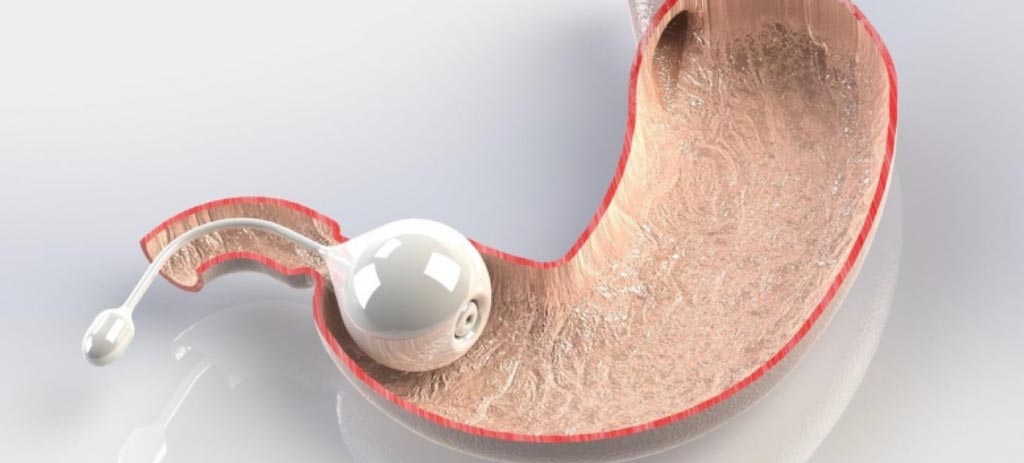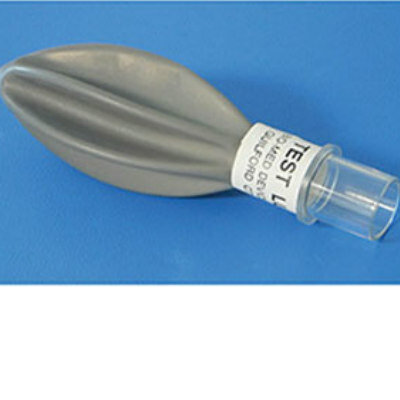Endoscopic Shuttle Insert Delays Gastric Emptying
|
By HospiMedica International staff writers Posted on 07 May 2019 |

Image: The TransPyloric shuttle (TPS) slows down food passage through the GI tract (Photo courtesy of BAROnova).
An innovative device provides a non-surgical weight loss solution for adult individuals suffering from obesity.
The BAROnova (San Carlos, CA, USA) TransPyloric Shuttle (TPS) is a mechanically constructed device the size of a small peach (5.6 cm in diameter), made of solid silicone components that is designed to delay gastric emptying by slowing the passage of food through the pylorus, causing patients to feel full sooner and stay full longer. The TPS is designed to be inserted and removed trans-orally using standard endoscopic techniques, and is intended for a 12-month treatment cycle, allowing patients the opportunity to achieve more durable lifestyle changes and health benefits.
In a randomized, sham-controlled study that enrolled 302 patients from nine investigational centers, patients treated with the TPS device lost on average 3.4 times (9.5%) more weight than the sham-control group (2.8%) at 12-month follow up, and 40% lost over 10% of their body weight. Improvements in blood pressure and other cardiometabolic risk factors, as well as quality of life, were also observed with TPS treatment. The most common adverse events were gastrointestinal, such as stomach pain, nausea, vomiting, and dyspepsia.
“Endoscopically delivered intragastric devices can help close the obesity treatment gap and offer alternative options for qualified patients who are not eligible, or unwilling, to undergo metabolic and bariatric surgery,” said senior investigator Wayne English, MD, of Vanderbilt University. “The TPS device design addresses some of the limitations with the first-generation intragastric devices and offers longer treatment duration, which is clinically attractive.”
“The TPS device is unique in its treatment efficacy and duration. Further validation of potential comorbidity benefits, like cardiometabolic improvement observed in the pivotal study, during the post-market phase may translate to important advantages in achieving healthcare coverage for the TPS device in the future,” said Lian Cunningham, MD, PhD, senior VP of clinical and regulatory affairs at BAROnova. “We look forward to bringing this new technology to patients and physicians.”
Slow gastric emptying increases stomach distension, which activates stretch receptors. The vagus nerve carries the afferent signals related to stomach distension to the nucleus tractus solitarii (NTS) in the medulla, facilitating satiety by projections to the appetite-regulating nuclei of the hypothalamus.
Related Links:
BAROnova
The BAROnova (San Carlos, CA, USA) TransPyloric Shuttle (TPS) is a mechanically constructed device the size of a small peach (5.6 cm in diameter), made of solid silicone components that is designed to delay gastric emptying by slowing the passage of food through the pylorus, causing patients to feel full sooner and stay full longer. The TPS is designed to be inserted and removed trans-orally using standard endoscopic techniques, and is intended for a 12-month treatment cycle, allowing patients the opportunity to achieve more durable lifestyle changes and health benefits.
In a randomized, sham-controlled study that enrolled 302 patients from nine investigational centers, patients treated with the TPS device lost on average 3.4 times (9.5%) more weight than the sham-control group (2.8%) at 12-month follow up, and 40% lost over 10% of their body weight. Improvements in blood pressure and other cardiometabolic risk factors, as well as quality of life, were also observed with TPS treatment. The most common adverse events were gastrointestinal, such as stomach pain, nausea, vomiting, and dyspepsia.
“Endoscopically delivered intragastric devices can help close the obesity treatment gap and offer alternative options for qualified patients who are not eligible, or unwilling, to undergo metabolic and bariatric surgery,” said senior investigator Wayne English, MD, of Vanderbilt University. “The TPS device design addresses some of the limitations with the first-generation intragastric devices and offers longer treatment duration, which is clinically attractive.”
“The TPS device is unique in its treatment efficacy and duration. Further validation of potential comorbidity benefits, like cardiometabolic improvement observed in the pivotal study, during the post-market phase may translate to important advantages in achieving healthcare coverage for the TPS device in the future,” said Lian Cunningham, MD, PhD, senior VP of clinical and regulatory affairs at BAROnova. “We look forward to bringing this new technology to patients and physicians.”
Slow gastric emptying increases stomach distension, which activates stretch receptors. The vagus nerve carries the afferent signals related to stomach distension to the nucleus tractus solitarii (NTS) in the medulla, facilitating satiety by projections to the appetite-regulating nuclei of the hypothalamus.
Related Links:
BAROnova
Latest Surgical Techniques News
- Robotic Assistant Delivers Ultra-Precision Injections with Rapid Setup Times
- Minimally Invasive Endoscopic Surgery Improves Severe Stroke Outcomes
- Novel Glue Prevents Complications After Breast Cancer Surgery
- Breakthrough Brain Implant Enables Safer and More Precise Drug Delivery
- Bioadhesive Sponge Stops Uncontrolled Internal Bleeding During Surgery
- Revolutionary Nano Bone Material to Accelerate Surgery and Healing
- Superior Orthopedic Implants Combat Infections and Quicken Healing After Surgery
- Laser-Based Technique Eliminates Pancreatic Tumors While Protecting Healthy Tissue
- Surgical Treatment of Severe Carotid Artery Stenosis Benefits Blood-Brain Barrier
- Revolutionary Reusable Duodenoscope Introduces 68-Minute Sterilization
- World's First Transcatheter Smart Implant Monitors and Treats Congestion in Heart Failure
- Hybrid Endoscope Marks Breakthrough in Surgical Visualization
- Robot-Assisted Bronchoscope Diagnoses Tiniest and Hardest to Reach Lung Tumors
- Diamond-Titanium Device Paves Way for Smart Implants that Warn of Disease Progression
- 3D Printable Bio-Active Glass Could Serve as Bone Replacement Material
- Spider-Inspired Magnetic Soft Robots to Perform Minimally Invasive GI Tract Procedures
Channels
Critical Care
view channel
CPR Guidelines Updated for Pediatric and Neonatal Emergency Care and Resuscitation
Cardiac arrest in infants and children remains a leading cause of pediatric emergencies, with more than 7,000 out-of-hospital and 20,000 in-hospital cardiac arrests occurring annually in the United States.... Read more
Ingestible Capsule Monitors Intestinal Inflammation
Acute mesenteric ischemia—a life-threatening condition caused by blocked blood flow to the intestines—remains difficult to diagnose early because its symptoms often mimic common digestive problems.... Read more
Wireless Implantable Sensor Enables Continuous Endoleak Monitoring
Endovascular aneurysm repair (EVAR) is a life-saving, minimally invasive treatment for abdominal aortic aneurysms—balloon-like bulges in the aorta that can rupture with fatal consequences.... Read more
Wearable Patch for Early Skin Cancer Detection to Reduce Unnecessary Biopsies
Skin cancer remains one of the most dangerous and common cancers worldwide, with early detection crucial for improving survival rates. Traditional diagnostic methods—visual inspections, imaging, and biopsies—can... Read morePatient Care
view channel
Revolutionary Automatic IV-Line Flushing Device to Enhance Infusion Care
More than 80% of in-hospital patients receive intravenous (IV) therapy. Every dose of IV medicine delivered in a small volume (<250 mL) infusion bag should be followed by subsequent flushing to ensure... Read more
VR Training Tool Combats Contamination of Portable Medical Equipment
Healthcare-associated infections (HAIs) impact one in every 31 patients, cause nearly 100,000 deaths each year, and cost USD 28.4 billion in direct medical expenses. Notably, up to 75% of these infections... Read more
Portable Biosensor Platform to Reduce Hospital-Acquired Infections
Approximately 4 million patients in the European Union acquire healthcare-associated infections (HAIs) or nosocomial infections each year, with around 37,000 deaths directly resulting from these infections,... Read moreFirst-Of-Its-Kind Portable Germicidal Light Technology Disinfects High-Touch Clinical Surfaces in Seconds
Reducing healthcare-acquired infections (HAIs) remains a pressing issue within global healthcare systems. In the United States alone, 1.7 million patients contract HAIs annually, leading to approximately... Read moreHealth IT
view channel
Printable Molecule-Selective Nanoparticles Enable Mass Production of Wearable Biosensors
The future of medicine is likely to focus on the personalization of healthcare—understanding exactly what an individual requires and delivering the appropriate combination of nutrients, metabolites, and... Read moreBusiness
view channel
Philips and Masimo Partner to Advance Patient Monitoring Measurement Technologies
Royal Philips (Amsterdam, Netherlands) and Masimo (Irvine, California, USA) have renewed their multi-year strategic collaboration, combining Philips’ expertise in patient monitoring with Masimo’s noninvasive... Read more
B. Braun Acquires Digital Microsurgery Company True Digital Surgery
The high-end microsurgery market in neurosurgery, spine, and ENT is undergoing a significant transformation. Traditional analog microscopes are giving way to digital exoscopes, which provide improved visualization,... Read more
CMEF 2025 to Promote Holistic and High-Quality Development of Medical and Health Industry
The 92nd China International Medical Equipment Fair (CMEF 2025) Autumn Exhibition is scheduled to be held from September 26 to 29 at the China Import and Export Fair Complex (Canton Fair Complex) in Guangzhou.... Read more












